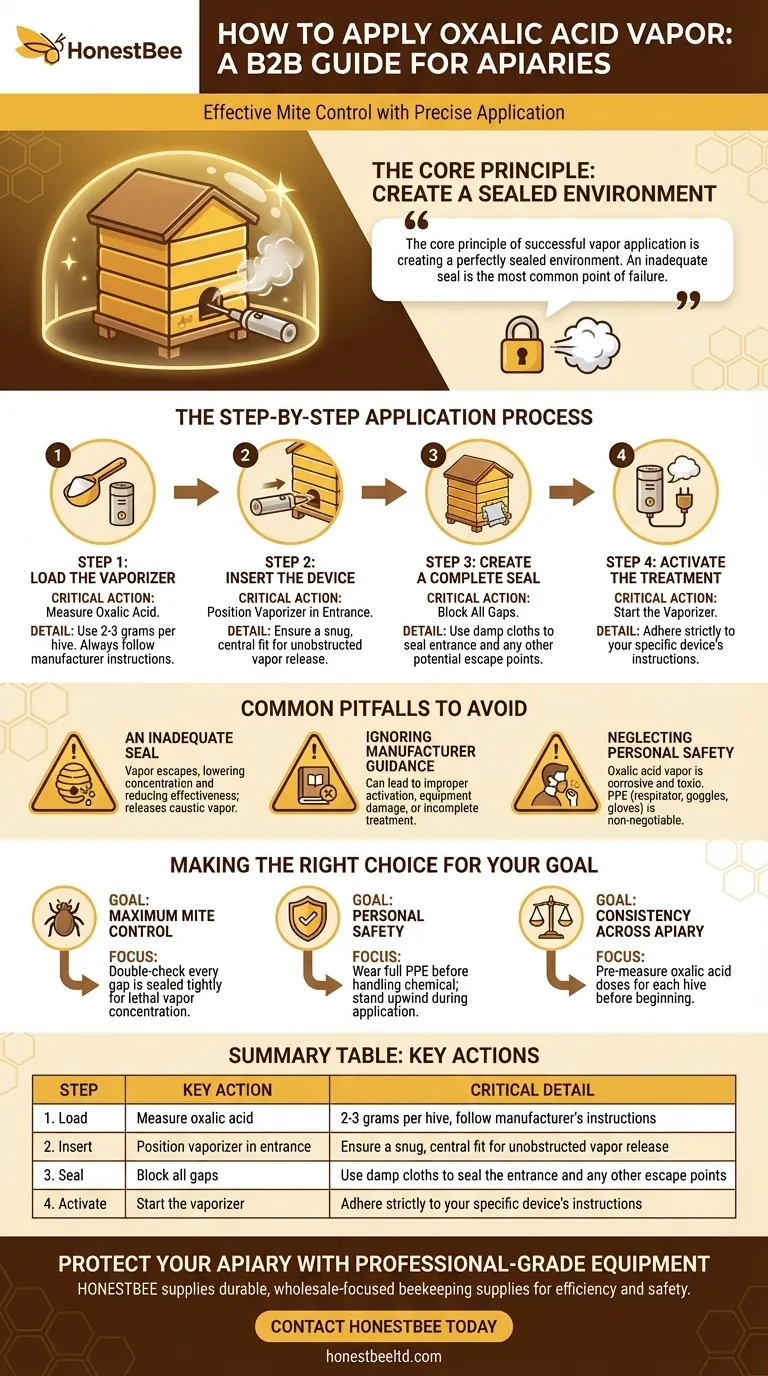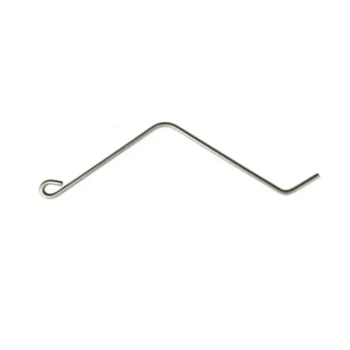To apply oxalic acid vapor, the vaporizer is carefully inserted into the hive entrance and any surrounding gaps are sealed with a damp cloth to create a contained environment. Once the hive is sealed, the device is loaded with the correct dose of oxalic acid and activated according to the manufacturer's instructions, allowing the vapor to fill the hive and treat the bees.
The core principle of successful vapor application is creating a perfectly sealed environment. An inadequate seal is the most common point of failure, reducing the treatment's effectiveness against varroa mites and increasing risk to the operator.

The Step-by-Step Application Process
Achieving an effective treatment requires a methodical approach. Each step is designed to maximize vapor concentration within the hive while ensuring safety.
Step 1: Load the Vaporizer
Before approaching the hive, load the vaporizer with the appropriate amount of oxalic acid. A typical dose is between 2 and 3 grams per hive, but you must always follow the specific instructions for your equipment.
Step 2: Insert the Device
Carefully slide the vaporizer into the main hive entrance. Your goal is to position it so the vapor can be released centrally without being obstructed, ensuring a snug fit.
Step 3: Create a Complete Seal
This is the most critical mechanical step. Use damp cloths or rags to block the entire hive entrance around the vaporizer. Seal any other potential escape points, such as upper entrances or gaps in the hive body, to prevent vapor from leaking out.
Step 4: Activate the Treatment
Activate the vaporizer. The method for this varies significantly between models—some are connected to a power source like a car battery, while others may have a different ignition method. Always adhere strictly to the manufacturer’s instructions for your specific device.
Common Pitfalls to Avoid
The effectiveness of this treatment hinges on proper execution. Avoiding these common errors is essential for both mite control and personal safety.
An Inadequate Seal
Even small gaps allow the vapor to escape. This lowers the concentration of oxalic acid inside the hive, potentially making the treatment ineffective. A poor seal also releases caustic vapor into the air, creating a safety hazard.
Ignoring Manufacturer Guidance
Different vaporizers operate differently. Assuming you know how to use a new model without reading the instructions can lead to improper activation, equipment damage, or an incomplete treatment cycle.
Neglecting Personal Safety
Oxalic acid vapor is corrosive and highly toxic when inhaled. Handling the chemical and applying the vapor requires appropriate Personal Protective Equipment (PPE), including a properly rated respirator, safety goggles, and gloves. This is a non-negotiable aspect of the procedure.
Making the Right Choice for Your Goal
Your primary objective will dictate where you focus your attention during the process.
- If your primary focus is maximum mite control: Double-check that every gap in the hive is sealed tightly to maintain a lethal vapor concentration for the full duration of the treatment.
- If your primary focus is personal safety: Wear your full PPE before you even open the oxalic acid, and stand upwind from the hive during application.
- If your primary focus is consistency across your apiary: Pre-measure your oxalic acid doses for each hive before you begin so that every colony receives the correct, uniform treatment.
A precise and methodical application is the key to protecting your bees effectively and safely.
Summary Table:
| Step | Key Action | Critical Detail |
|---|---|---|
| 1. Load | Measure oxalic acid | Use 2-3 grams per hive, follow manufacturer's instructions |
| 2. Insert | Position vaporizer in entrance | Ensure a snug, central fit for unobstructed vapor release |
| 3. Seal | Block all gaps | Use damp cloths to seal the entrance and any other escape points |
| 4. Activate | Start the vaporizer | Adhere strictly to your specific device's instructions |
Protect Your Apiary with Professional-Grade Equipment
A successful oxalic acid treatment depends on reliable equipment and precise application. For commercial apiaries and beekeeping equipment distributors, HONESTBEE supplies durable, wholesale-focused beekeeping supplies designed for efficiency and safety.
Contact HONESTBEE today to discuss your wholesale needs and ensure your mite control treatments are consistently effective.
Visual Guide

Related Products
- Adjustable Formic and Acetic Acid Dispenser for Bee Mite Treatment
- HONESTBEE Advanced Ergonomic Stainless Steel Hive Tool for Beekeeping
- Langstroth Screen Bottom Board for Beekeeping Wholesale
- Professional Dual-End Stainless Steel Hive Tool for Beekeeping
- Economy Small Scale Honey Dryer Dehumidifier Thickening Machine
People Also Ask
- What does Chewed Down Brood (CDB) indicate in bee colonies? A Sign of Varroa Mite Infestation
- What are the symptoms of Varroa Mite Syndrome (VMS)? Recognizing the Signs of Colony Collapse
- How can beekeepers ensure their hives survive the winter? A Guide to Colony Survival
- What should beekeepers do to manage varroa mites effectively? Adopt a Proactive Monitoring Strategy
- What are some common predators and pests that target beehives? Protect Your Hives from Bears, Mites, and Beetles



















